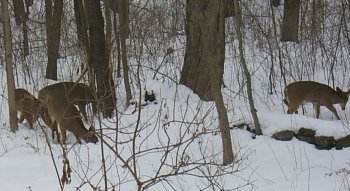- By Dan Veaner
- Around Town
 Print
Print  Village of Lansing Trustees considered a resolution to ask legislators to establish a county-wide program to control an out-of-control deer population. The deer problem has been an ongoing topic of discussion for the Trustees, but Village officials have limited resources to control it. "They're all over the Village," says Mayor Don Hartill. "I have four or five that camp out in our back yard all the time. I think they're fairly uniformly distributed around the Village. There are no predators except for cars."
Village of Lansing Trustees considered a resolution to ask legislators to establish a county-wide program to control an out-of-control deer population. The deer problem has been an ongoing topic of discussion for the Trustees, but Village officials have limited resources to control it. "They're all over the Village," says Mayor Don Hartill. "I have four or five that camp out in our back yard all the time. I think they're fairly uniformly distributed around the Village. There are no predators except for cars."In addition to damage done in collisions with drivers, Trustees worried about damage to new trees planted for the Triphammer Road reconstruction project, as well as residents' trees and gardens. Trustee Lynn Leopold said she had been told of a repellent called Deer Fortress, a safe repellent that smells of blood to deer, causing them to go away from perceived danger. She suggested that it wouldn't be hard to create a home-made version of the repellant. "Nothing is totally deer-proof," lamented Leopold. "This stuff really does spook them, though. It's worth a try."
Trustees considered other ways to protect the trees that might be effective and attractive, but the consensus was that there are just too many deer in the Village. Hartill says that between collisions with automobiles and an invitational bow hunt on the Sundown Farms property the deer population was reasonably controlled in the Village. He says the hunt yielded about 30 deer per year. But after abuses in the hunt, including uninvited people joining the hunt, the property owner put a halt to the hunt. "The reason was that there were complaints of violations by some of the visitors," explains Trustee Frank Moore. "And that's the landowner's responsibility, so not surprisingly the landowner said he doesn't need this grief."
According to a Cornell Cooperative Extension fact sheet, there was a 39% rise in fatal car crashes nationwide involving animals between reporting periods 1992-1995 and 1998-2001. More than 1.5 million deer/vehicle crashes were reported in 2002, causing more than $1.1 billion in damage, and killing 150 people and at least 1.5 million deer. Most of these collisions occur during the breeding season in October and November, with a lesser peak in May and June.
With the herd population out of control, Trustees worried that trees and gardens in the Village will be decimated. They noted that after deer have eaten plants that they like they go on to eat less attractive foods. "A few years ago when we had three feet of snow they destroyed my blue spruce," Hartill noted.

Deer in Lansing: an overside herd decimates the landscape
as food becomes scarce in winter
Moore expressed support for drafting a resolution similar to one recently proposed by the Village of Cayuga Heights. The resolution requests the Council of Governments to establish and implement a county-wide deer-reduction program. But Moore noted that the Council of Governments doesn't have the authority to implement such a program, though it can help negotiate one. "The good thing about the Cayuga Heights resolution is that it is putting a push on this subject," Moore said. "Nobody is facing the issue of culling."
He sited a New York Times article that reports on aggressive deer culling on Long Island, saying that municipalities could encourage bow-hunts by offering tax incentives to landowners who allow hunts on their property. "I think we should have our own resolution that would endorse this resolution from Cayuga Heights," he said.
Hartill asked Moore to draft a resolution that the Trustees could vote to adopt, and Moore agreed. "It's a county-wide problem, and the County needs to take responsibility," Hartill said.
----
v2i47



